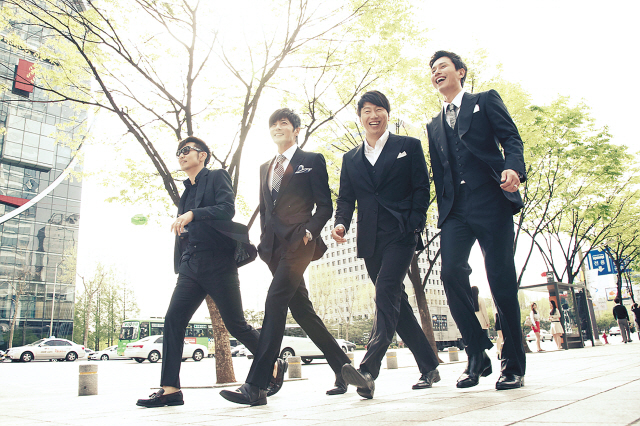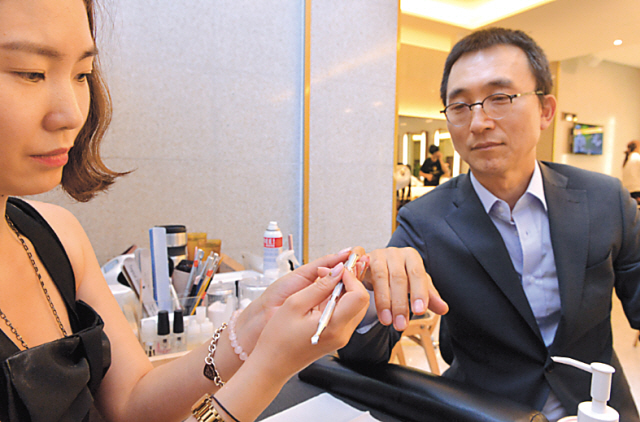A look into the real-life 40-something man-about-town
In the much-talked-about, much-watched “A Gentleman’s Dignity,” men are portrayed as skincare-conscious 40-something dudes who hang out at cafes and are not afraid to gush over their non-alcoholic beverages or be seen shopping together.
With viewer ratings up in the 20 percent range, this oft-called male version of “Sex and the City” is a hot commodity, but are the attractive, sensitive, metrosexual leading men in the show a far-fetched image of middle-aged male society or for real?
“I think that ‘A Gentleman’s Dignity’ does reflect societal trends, to a certain extent,” said men’s magazine Leon Korea editor-in-chief Sheen Dong-sun.
In the much-talked-about, much-watched “A Gentleman’s Dignity,” men are portrayed as skincare-conscious 40-something dudes who hang out at cafes and are not afraid to gush over their non-alcoholic beverages or be seen shopping together.
With viewer ratings up in the 20 percent range, this oft-called male version of “Sex and the City” is a hot commodity, but are the attractive, sensitive, metrosexual leading men in the show a far-fetched image of middle-aged male society or for real?
“I think that ‘A Gentleman’s Dignity’ does reflect societal trends, to a certain extent,” said men’s magazine Leon Korea editor-in-chief Sheen Dong-sun.

“Men really do chat,” said Sheen, 41. “Now, instead of moving onto drinks after dinner, guys are going out for coffee, where they sit down, chat and then call it a day.”
“Since we first opened in South Korea in 1999, there has been a rise in the number of men who use our cafes as a gathering spot,” said a Starbucks Korea representative who observed that male cafe-goers are still outnumbered by female customers.
As for the skincare products that the male leads, namely Lee Jeong-rok (Lee Jong-hyeok), are seen using in the program, Sheen said that there has been a noticeable increase in interest in beauty products and services among men in their 30s and 40s.
Considering the explosion in diversity and variety of men’s skincare products in the Korean cosmetics market, it is not hard to believe that men are increasingly more invested in taking care of their complexion.
Take Amore Pacific for instance. The Korean company launched its “prestige” men’s cosmetics brand, Hera Homme, in 2005.
Hera Homme then went on to release its first blemish balm (a sort-of multi-purpose tinted moisturizer) in 2010 and just released a three-step skin tone-focused “cell brightening” line this month.
Blemish balm is nothing new to the world of men’s cosmetics. Media coverage of the tinted moisturizer and its more extreme cousins has been extensive, but if anything has changed over the years, it looks like the blemish balm-wearing age group might be getting broader.
“The consumer range that buys blemish balm is growing,” Hera Homme PR specialist Park Sung-min said. “In the past, young men were the primary consumers, but now many office workers also purchase the balm.”
“The age bracket for blemish balm seems to extend up to men in their early 30s but not further than that,” said Leon Korea marketing manager Oh Min-soo.
Park, however, said she heard some men in their 40s ― the age group portrayed in “A Gentleman’s Dignity” ― also seek out blemish balm.
“Those in their early-to-mid-40s, an age bracket now-dubbed the ‘blossom of middle age,’ are showing growing interest in personal upkeep,” Park said, adding that their premium Black line attracts that age group and that the average Hera Homme customer is aged 30 to 39.
According to new reports, the men’s cosmetics market has been showing an annual growth rate of over 15 percent. This year, it is predicted the market will reach the one trillion won ($881 million) mark.
When it comes to makeup though, it looks like blemish balm is about as far as the average Joe will go.

“I just do not think the trend really goes beyond blemish balm,” said Boboris Salon and Spa director Song Si-hoo.
If blemish balm stands out as the mascot of the men’s makeup sector, the male skincare market itself seems to be growing in the spa treatment sector, leading to the catchphrase “grooming tribe.”
Men are getting facials, manicures and having their eyebrows waxed.
“These days there is a trend amongst men toward doing eyebrow waxing,” said Boboris Salon and Spa creative director Esther Kim.
Song, however, stressed that it is more common amongst young men.
Boboris, which opened in Seoul this February, offers skincare, nail care and brow waxing services for men.
“Out of the three, manicures are the most popular,” said Kim, 38, who explained that men get a simple manicure to make their nails look clean and neat. “They get their cuticles and nail length taken care of.”
“There are quite a few men who get manicures,” said Leon Korea’s Oh, 38, who added that when men go to get their hair cut, the salon might recommend it as an additional service, and then it just becomes part of the whole grooming package.
“Facials are our second most popular spa treatment for men,” said Boboris’ Song. Many men opt for pore tightening and acne-zapping treatments.
Men in their late 20s to mid-40s form Boboris’ main male clientele, a sign that, indeed, intensive grooming is not necessarily restricted to young trendsetters.
The new salon created a separate floor for VIP clients and men because “men these days are very interested in fashion and hair” and need a trendy spot to meet their needs, said Song.
Both the recent opening of Boboris and the launching of the first Korean edition of the Japanese men’s magazine Leon this March signal a growing target segment of middle-aged men who are into trends, lifestyle and fashion.
While the Korean men’s magazine market is over a decade old and already sports a slew of publications like the Korean editions of Esquire, GQ, Arena and Maxim, it looks there is still room for a new magazine that targets middle-aged male readers.
“In the past, men in their 30s were too busy making a living but we noticed that that has now changed,” said Sheen.
Leon Korea’s main readers are men in their 30s and 40s, said Oh.
“They are Generation X,” Oh added, describing the generation’s males as guys who spent their youth in the 90s, when K-pop was blossoming and it was cool to pierce your ears, dress in fashionable hip-hop attire and drive a flashy car.
“Those guys are now in their 40s and they are not scared to dress up,” he said.
Generation X, then, is the same generation that the male leads of “A Gentleman’s Dignity” hail from in their fictional world, a world whose men are fashionable and chic.
In this world of make-believe, the male characters, save for Lee Jeong-rok, are single, and two, including Jang Dong-gun’s Kim Do-jin, have never been married. Just how accurate a portrayal is this of that age group?
According to a survey by Statistics Korea, the percentage of single men in their early 40s went up from 2.6 percent in 1995 to 14.8 percent in 2010, an indication that “A Gentleman’s Dignity” is not too far off the mark in that department.
Some aspects of the drama, though, in Oh’s opinion are not reflective of actual societal trends.
“The mart scene seems exaggerated,” Oh said referring to the scene where the four male characters go shopping together.
Sheen added that while men do shop alone these days, she does not think that men tend to shop together.
“That is not a widespread trend,” Sheen said.
Oh is also careful not to give the impression that the average 40-something man is a mirror image of one of the characters out of “A Gentleman’s Dignity.”
The main male characters, said Oh, are around his age.
“I can relate to that. I can see that around me, but outside my industry, it is harder to see that among my middle-aged friends.”
By Jean Oh (oh_jean@heraldcorp.com)
-
Articles by Korea Herald








![[From the Scene] Monks, Buddhists hail return of remains of Buddhas](http://res.heraldm.com/phpwas/restmb_idxmake.php?idx=644&simg=/content/image/2024/04/19/20240419050617_0.jpg&u=20240419175937)






![[From the Scene] Monks, Buddhists hail return of remains of Buddhas](http://res.heraldm.com/phpwas/restmb_idxmake.php?idx=652&simg=/content/image/2024/04/19/20240419050617_0.jpg&u=20240419175937)

![[KH Explains] Hyundai's full hybrid edge to pay off amid slow transition to pure EVs](http://res.heraldm.com/phpwas/restmb_idxmake.php?idx=652&simg=/content/image/2024/04/18/20240418050645_0.jpg&u=20240419100350)

![[Today’s K-pop] Illit drops debut single remix](http://res.heraldm.com/phpwas/restmb_idxmake.php?idx=642&simg=/content/image/2024/04/19/20240419050612_0.jpg&u=)